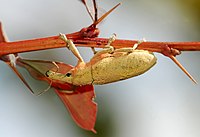
Photo from wikipedia
Beetles (Coleoptera) are a charismatic group of insects targeted by collectors and often used in biodiversity surveys. As part of a larger project, we surveyed a small (4 hectare) plot… Click to show full abstract
Beetles (Coleoptera) are a charismatic group of insects targeted by collectors and often used in biodiversity surveys. As part of a larger project, we surveyed a small (4 hectare) plot in the Boston Mountains of Arkansas using 70 traps of 12 trap types and Berlese–Tullgren extraction of leaf litter and identified all Buprestidae, Carabidae, Cerambycidae, and Curculionoidea (Anthribidae, Attelabidae, Brachyceridae, Brentidae, and Curculionidae excluding Scolytinae) to species. This resulted in the collection of 7,973 specimens representing 242 species arranged in 8 families. In a previous publication, we reported new state records and the number of specimens collected per species. In this publication, we used these data to determine the most effective collection method for four beetle groups: Carabidae, Cerambycidae, Curculionoidea (excluding Scolytinae), and Buprestidae. We found that the combination of pitfall and Malaise traps was most effective for Carabidae, Cerambycidae, and Curculionoidea, but that the combination of Malaise and green Lindgren funnel traps was most effective at collecting Buprestidae. Species accumulation curves did not become asymptotic and extrapolated rarefaction curves did not become asymptotic until 350–1,000 samples, suggesting that much more effort is required to completely inventory even a small site. Additionally, seasonal activity is presented for each species and the similarity and overlap between collecting dates and seasons is discussed for each family.
Journal Title: Journal of Insect Science
Year Published: 2017
Link to full text (if available)
Share on Social Media: Sign Up to like & get
recommendations!